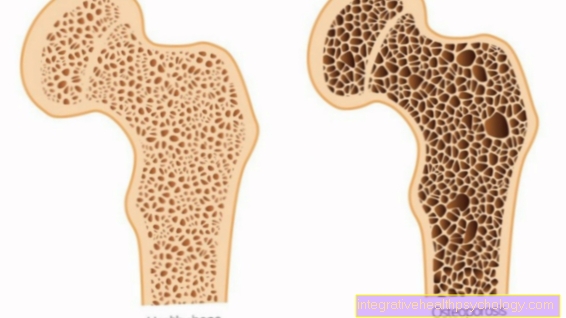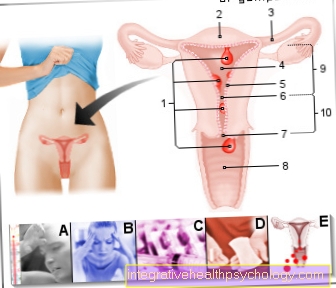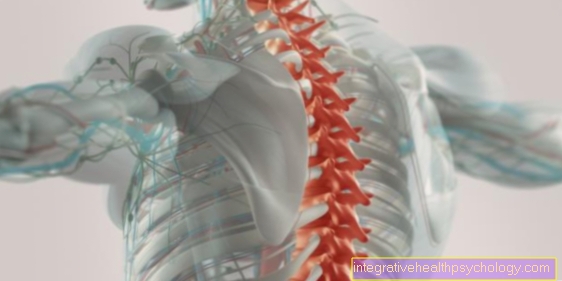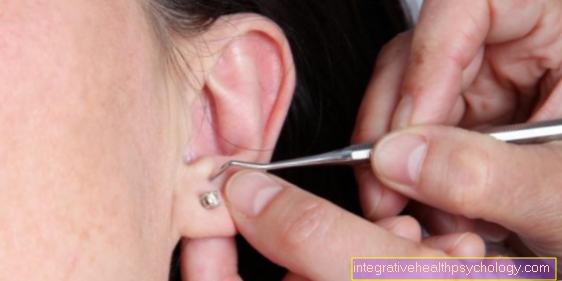Parotid cancer
What is parotid gland cancer?
In parotid cancer, officially known as parotid cancer, the patient suffers from a malignant tumor that originates in the tissue of his parotid gland. This lies under the skin in front of or under the ear. The cells of this gland produce most of the saliva and can degenerate through various influences, i.e. become malignant.
The resulting tumors then damage the surrounding tissue and the entire organism if they are not treated. Depending on the subtype, this damage looks different and the prognosis is very different from one individual to another. Parotid gland cancer is one of the rare tumors. The benign neoplasms of the parotid gland or cancers in other places are far more common.

What are the symptoms of parotid gland cancer?
Unfortunately, parotid gland cancer does not cause early symptoms, so it is either noticed by chance on imaging or not diagnosed until later. If the tumor is already large enough, it can be felt as a rough, non-movable knot and can be painful. If it infiltrates the nerves that run through the parotid glands, paralysis of the facial muscles can occur. In very advanced tumors, the skin shows changes above it.
Since there are different subtypes of parotid gland cancer, the tumors can behave atypically or cause no symptoms at all. Often they are initially misdiagnosed as enlarged lymph nodes. In such cases symptoms can only occur through metastases, e.g. in the lymph nodes, indicate a malignant tumor. Therefore, a clarification is always carried out if pain, facial paralysis or enlarged lymph nodes occur in this area.
Pain
Parotid pain can have many causes, with cancer being the most unlikely diagnosis. Inflammation of the parotid gland or surrounding structures is much more common and can cause severe pain and cause concern for the patient. Malignant tumors can also hurt, but the symptoms develop rather slowly and are uncomfortable, but usually not very severe.
Read more about this under: Pain in the parotid gland
Diagnosis of parotid gland cancer
Most patients go to their family doctor when the first complaint occurs, who then arranges for further diagnostics. Imaging is usually done first, e.g. an MRI and an ultrasound scan. However, only a microscopic analysis of the tissue is proof of cancer, so a sample must be taken and sent in. This is e.g. done by ENT doctors using a tiny needle during the ultrasound scan.
Therapy of parotid gland cancer
Malignant neoplasms must be removed, otherwise they will grow and affect the rest of the body. Depending on its size and extent, the tumor is surgically removed and the area may be irradiated again. The nerves within the gland are preserved as well as possible if they have not yet been infiltrated by the tumor, as otherwise facial paralysis is the result. In such cases, however, a transplant of a piece of nerve from another site could also be considered.
In addition to removing the parotid gland, depending on the findings, the surrounding lymph nodes are also removed, as tumor cells may have settled there. Chemotherapy can also be used to destroy any other scattered tumor cells in the rest of the body or to shrink very large tumors. These approaches would be curative, i.e. healing, and the patient is optimally cancer-free afterwards.
A palliative, i.e. purely symptom-relieving therapy, would be necessary if the tumor cannot be completely removed surgically, if it has already metastasized outside the surrounding lymph nodes or if it comes back after therapy.
Radiation for parotid cancer
Radiation is a process in which tissue is deliberately destroyed using X-rays. In the case of parotid gland cancer, radiation can be carried out after the tumor has been surgically removed (adjuvant chemo) in order to destroy any remaining tumor cells and prevent the tumor from recurring. Although this technique has improved significantly in recent years, side effects such as damage to healthy tissue can occur.
Read more about this under: Treatment by radiation therapy
Duration of parotid gland cancer
The course of parotid gland cancer varies greatly depending on the subtype. Very aggressive tumors become noticeable quickly and grow in a few weeks, while others remain undetected for months or years.
The treatment then goes very quickly, the patient has to go to the hospital for a few days for the surgical removal, radiation or chemotherapy requires regular visits to the clinic for a few weeks. Follow-up care lasts the longest, for which the patient is examined every few months for several years in order to detect a possible recurrence of the tumor early.
Is your parotid gland cancer curable?
If the tumor tissue is completely removed, the patient is considered cured. This is therefore possible in principle and also the rule for the less aggressive forms of parotid gland cancer. Unfortunately, some tumors are recognized very late or they are particularly malignant neoplasms, so that curative therapy is no longer possible and the patient ultimately dies of the disease after a few months or years.
Complication: metastases
Metastases are the spread of tumor cells via lymph or blood vessels, which lead to the development of daughter ulcers. As soon as the tumor grows into such a vessel, metastases are possible. Theoretically, this allows tumor cells to spread throughout the body. In parotid cancer, however, they are found almost exclusively in the surrounding lymph nodes, provided the tumor is really very advanced.
If only the first nodes of the lymphatic drainage are affected, the patient can be healed by removing these nodes. If too many lymph nodes are involved or if there are already metastases to other organs, the patient is no longer considered to be curable.
Causes of Parotid Gland Cancer
At the beginning of every cancer there is always the degeneration of one or more cells that lose their natural function, multiply rapidly and thus lead to a tumor. This happens through the interplay of several unfavorable factors that act on the cell until it loses its original role, divides unchecked and damages the structures around it.
Such negative factors are, for example, the genes that can promote tumor disease. Therefore, patients whose relatives have cancer have a significantly higher risk of developing tumors themselves. If, in addition to such a genetic predisposition, there is additional damage from radiation or unhealthy lifestyle habits such as smoking, the risk increases even further. This applies to almost all cancers.
Unfortunately, especially for parotid gland cancer, neither all triggering nor protective mechanisms are known, as it is a rare disease. Radiation in the head and neck area is currently the only sure trigger. Among other things, the influences of various substances such as asbestos or rubber products are discussed, but viruses could also play a role in the development of cancer. This is currently the subject of research.
Frequency of parotid cancer
Parotid gland cancer is very rare; with around 13,000 new cases per year, it accounts for less than 1% of all malignant tumors in Germany. Men have a slightly higher risk than women and this cancer hardly occurs before the age of 50. In addition, this neoplasm only accounts for around 20% of all parotid gland tumors, the rest are benign.
What types of cancer are there?
-
Vicious
Malignant or malignant tumors are what is commonly referred to as cancer. This tissue grows very quickly, damages surrounding structures and can spread as metastases into the rest of the body through contact with blood or lymph vessels. As a result, the cancer spreads throughout the body and becomes harder to fight. Malicious therefore means that these diseases can be fatal if left untreated.
-
Benign
Translated from Latin, tumor simply means "swelling" and is not necessarily to be equated with cancer. Benign or benign neoplasms are much more common than malignant and are also referred to as tumors by the doctor. Again, this is growing tissue that shouldn't actually grow, but usually does not cause any damage to the surrounding tissue or the rest of the body. When these structures become very large or functionally active, e.g. By producing hormones, they can cause symptoms and should be removed, but would not be fatal if left untreated.





























